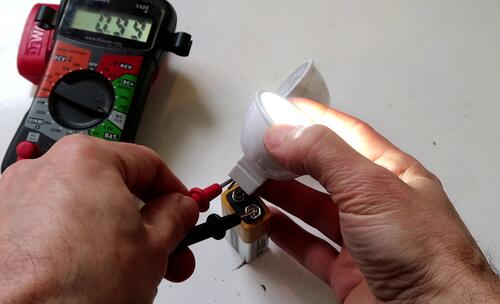 I bought one of these low voltage halogen replacement LED bulbs.
They can run on AC or DC and at different voltages. It can even run off a
9 volt battery, but drawing 1 ampere.
I bought one of these low voltage halogen replacement LED bulbs.
They can run on AC or DC and at different voltages. It can even run off a
9 volt battery, but drawing 1 ampere.
 I bought one of these low voltage halogen replacement LED bulbs.
They can run on AC or DC and at different voltages. It can even run off a
9 volt battery, but drawing 1 ampere.
I bought one of these low voltage halogen replacement LED bulbs.
They can run on AC or DC and at different voltages. It can even run off a
9 volt battery, but drawing 1 ampere.
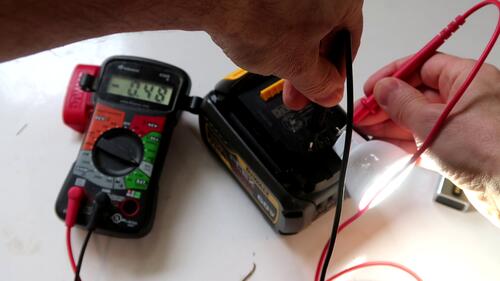 Connected to a 20 volt DeWalt battery, it draws just half an ampere.
So there appears to be some sort of regulator in the bulb that compensates for
the different voltages. So I'm pretty sure it's safe to run off the 20 volt
tool battery.
Connected to a 20 volt DeWalt battery, it draws just half an ampere.
So there appears to be some sort of regulator in the bulb that compensates for
the different voltages. So I'm pretty sure it's safe to run off the 20 volt
tool battery.
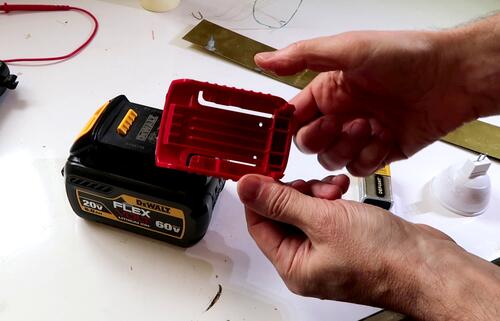 I wanted to make something to hook this bulb up to the battery, and for that
I needed something that clips onto the battery. These red guards that the batteries
ship with are just right for that. They even have holes right above
the contacts for the power.
I wanted to make something to hook this bulb up to the battery, and for that
I needed something that clips onto the battery. These red guards that the batteries
ship with are just right for that. They even have holes right above
the contacts for the power.
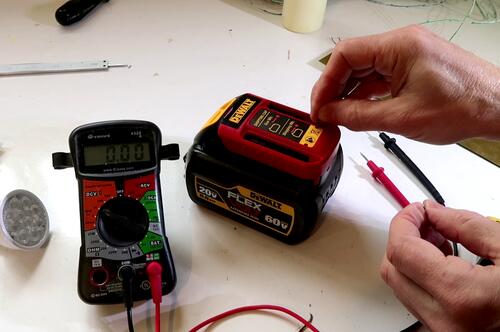 I stuck some nails in the holes, but measuring the voltage, I just get
a voltage that slowly drops. Examining it, I realized the red clip has two tabs
that push into the battery, and that probably disconnects the cells from the
rest of the circuitry.
I stuck some nails in the holes, but measuring the voltage, I just get
a voltage that slowly drops. Examining it, I realized the red clip has two tabs
that push into the battery, and that probably disconnects the cells from the
rest of the circuitry.
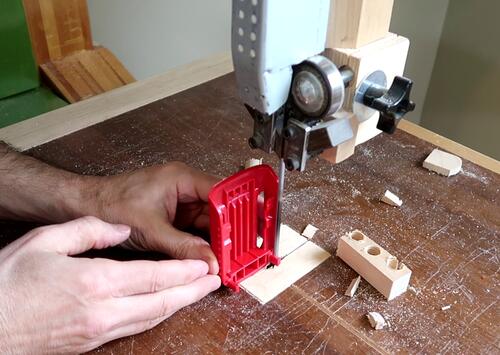 So I just cut the tabs off on the bandsaw.
So I just cut the tabs off on the bandsaw.
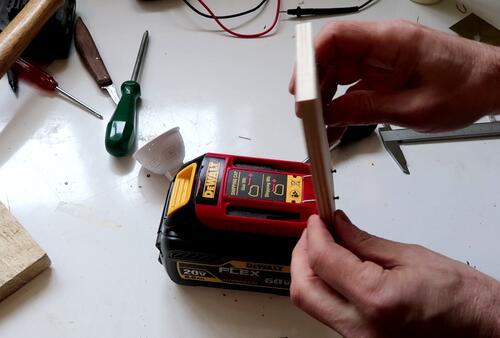 I then put two thin nails through a piece of plywood at the right spacing, so
the plywood sits on top of the clip.
I then put two thin nails through a piece of plywood at the right spacing, so
the plywood sits on top of the clip.
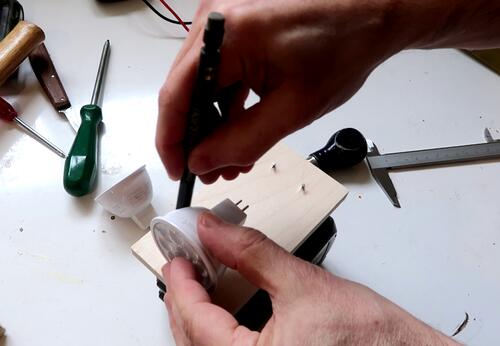
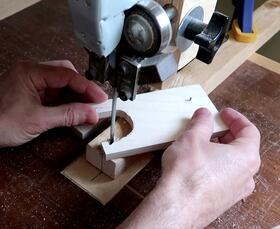 I wanted to attach the bulb to the plywood. I drew the outline of the bulb
on the plywood, then cut that out on the bandsaw.
I wanted to attach the bulb to the plywood. I drew the outline of the bulb
on the plywood, then cut that out on the bandsaw.
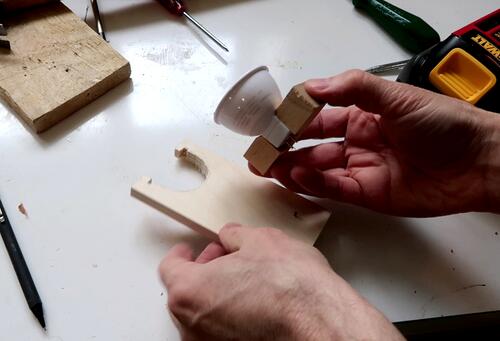
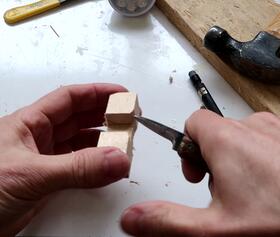 I also made another block of wood to fit around the base of the bulb. This
block screws onto the plywood.
I also made another block of wood to fit around the base of the bulb. This
block screws onto the plywood.
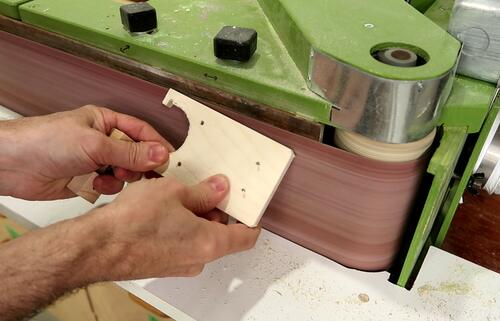
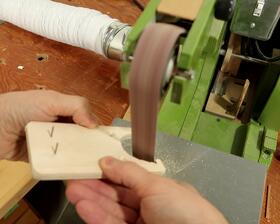 But before screwing it on, I rounded all the edges using my
belt sander and
strip sander.
But before screwing it on, I rounded all the edges using my
belt sander and
strip sander.
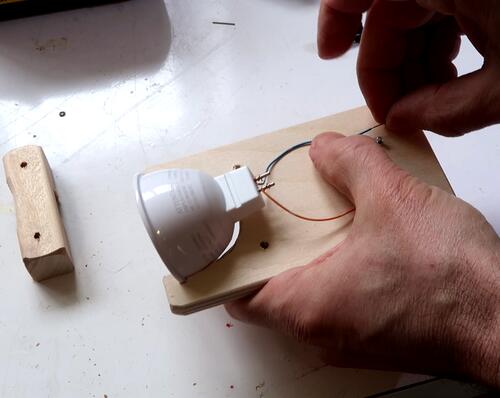 Then wiring the bulb to the nails with some telephone wire, just
twisted on.
Then wiring the bulb to the nails with some telephone wire, just
twisted on.
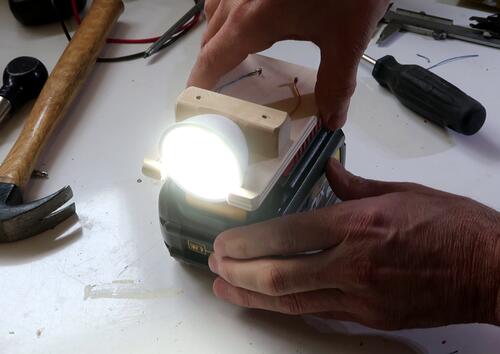 With the block that holds the bulb in place, I could call it done.
With the block that holds the bulb in place, I could call it done.
But I'm afraid of dropping some tool onto it and accidentally shorting out the battery.
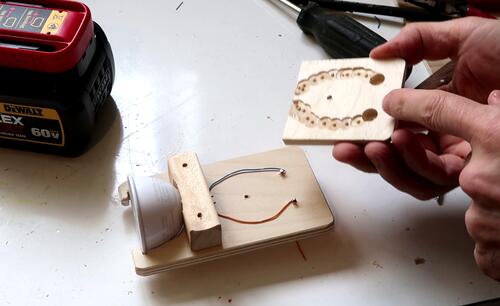
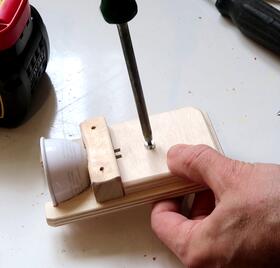 So I made this extra block of wood that fits over the nails and the
wires and is held in place with a screw.
So I made this extra block of wood that fits over the nails and the
wires and is held in place with a screw.
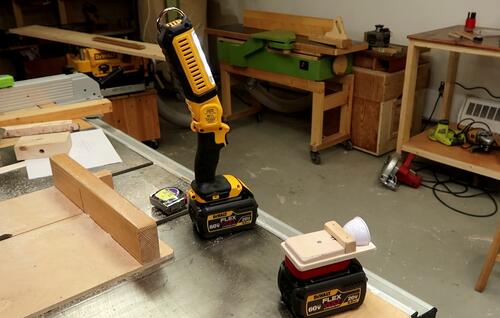 Of course, you could save all the trouble and just buy one of these
DeWalt work lights that clips onto the battery, but these work lights
are kind of expensive for what they are, and the LED bulbs cost
less than $10.
Of course, you could save all the trouble and just buy one of these
DeWalt work lights that clips onto the battery, but these work lights
are kind of expensive for what they are, and the LED bulbs cost
less than $10.
It would be cool if DeWalt (or someone else) made a similar small light that is small and cheap and just slips onto the battery, just to always keep in a tool box for when it's needed.
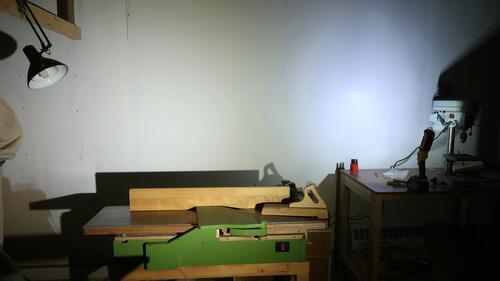 And here's comparing the light output. The LED bulb is an 8 watt bulb,
illuminating the spot on the left. The DeWalt work light is illuminating
the spot on the right. The DeWalt work light has a much wider beam, so
I put it much closer to the wall to get a better comparison.
Overall, I think the LED bulb puts out a bit more light, though I'm
sure it also uses more power.
And here's comparing the light output. The LED bulb is an 8 watt bulb,
illuminating the spot on the left. The DeWalt work light is illuminating
the spot on the right. The DeWalt work light has a much wider beam, so
I put it much closer to the wall to get a better comparison.
Overall, I think the LED bulb puts out a bit more light, though I'm
sure it also uses more power.
The reason I built this thing is that I use the DeWalt work lights to fill in some dark areas here and there while filming, and having another similar light could be handy. The more focused beam will be better some of the time, but less useful at other times.
A note of caution When I built this I assumed the battery pack would have under-voltage protection built in because the cheap 12-volt Ryobi battery packs I have will automatically shut off on under-voltage. But DeWalt tools have under-voltage cut-off in the tool itself, so the batteries don't need to. I imagine this is also the case for most larger cordless tools. So don't plug one of these in and leave it unattended.